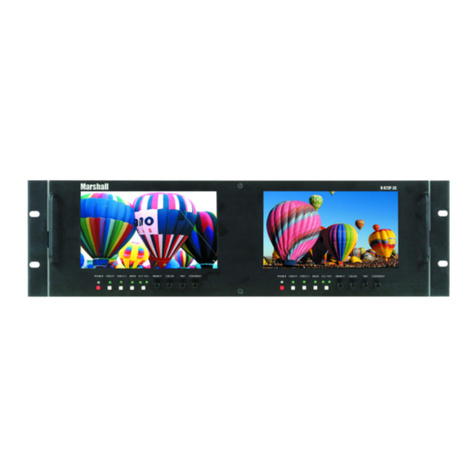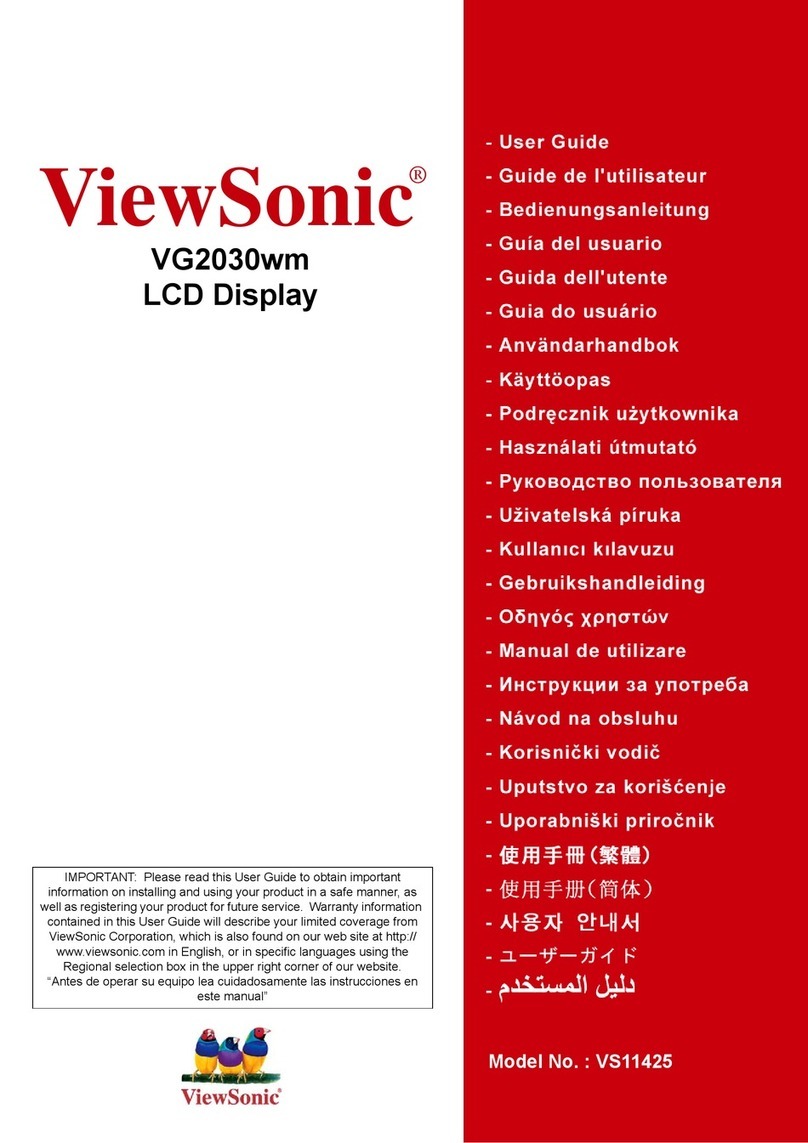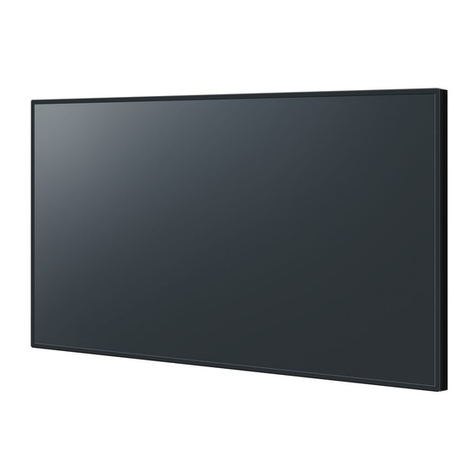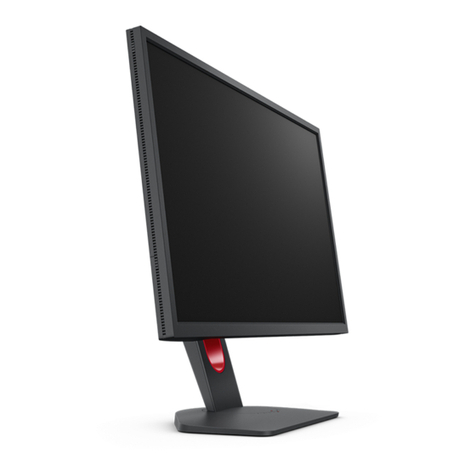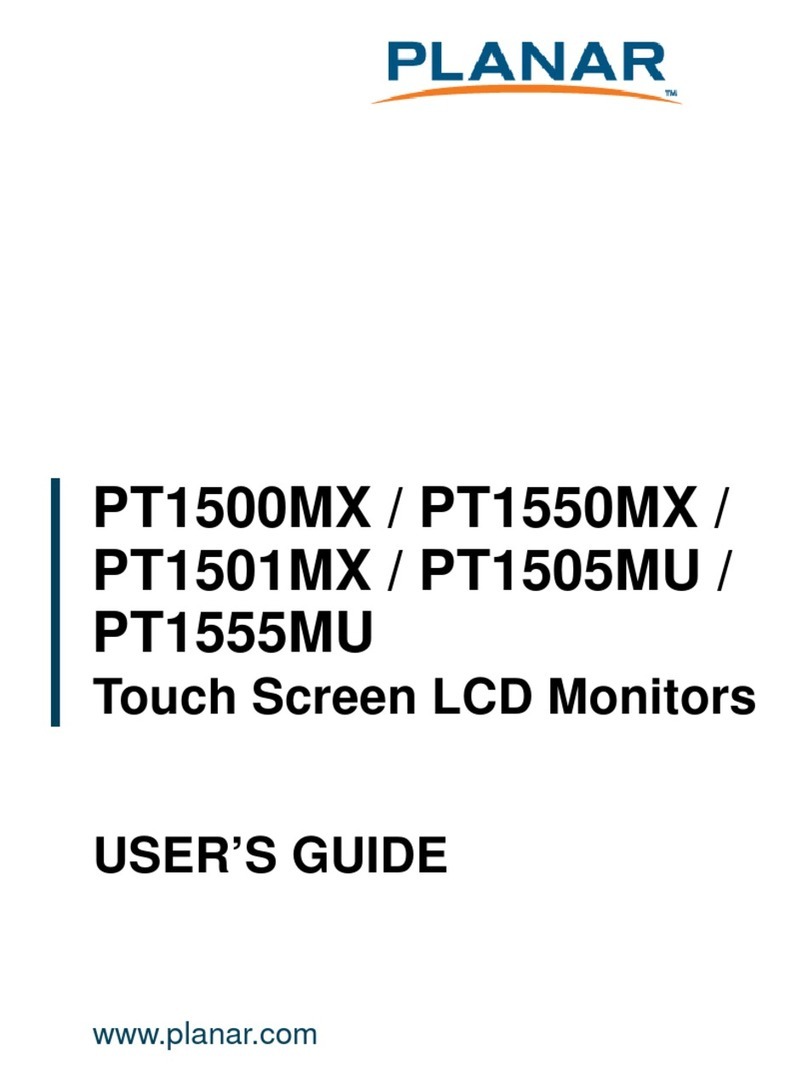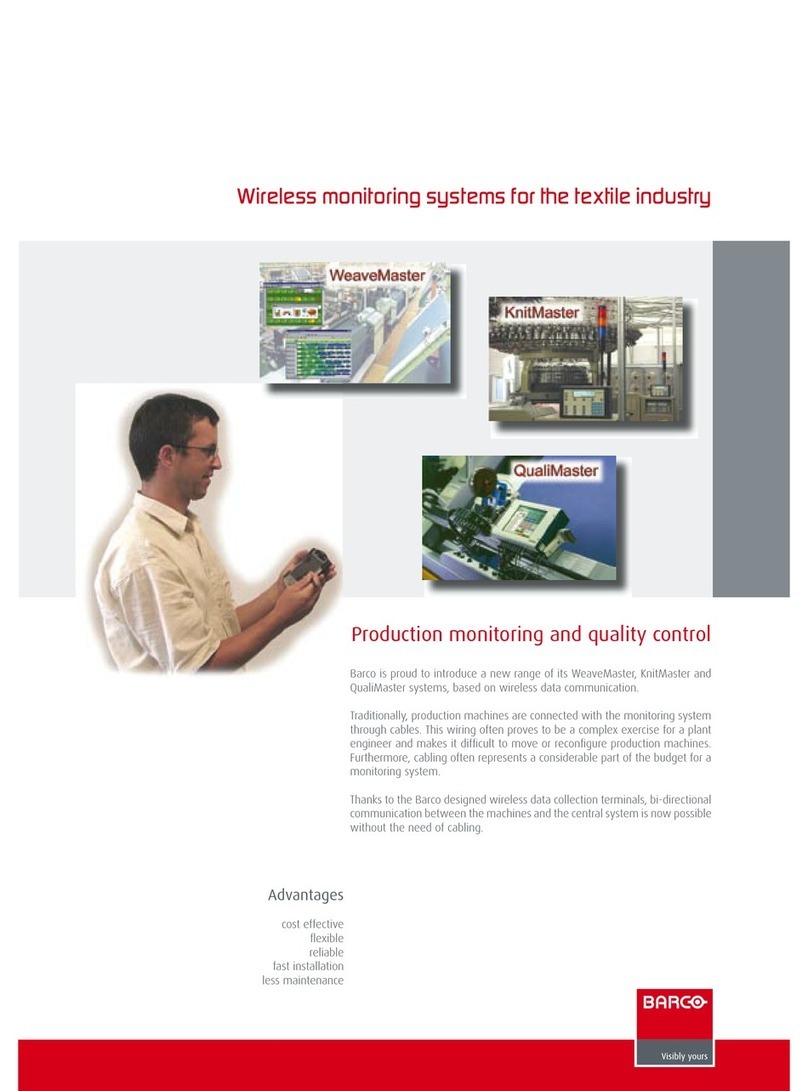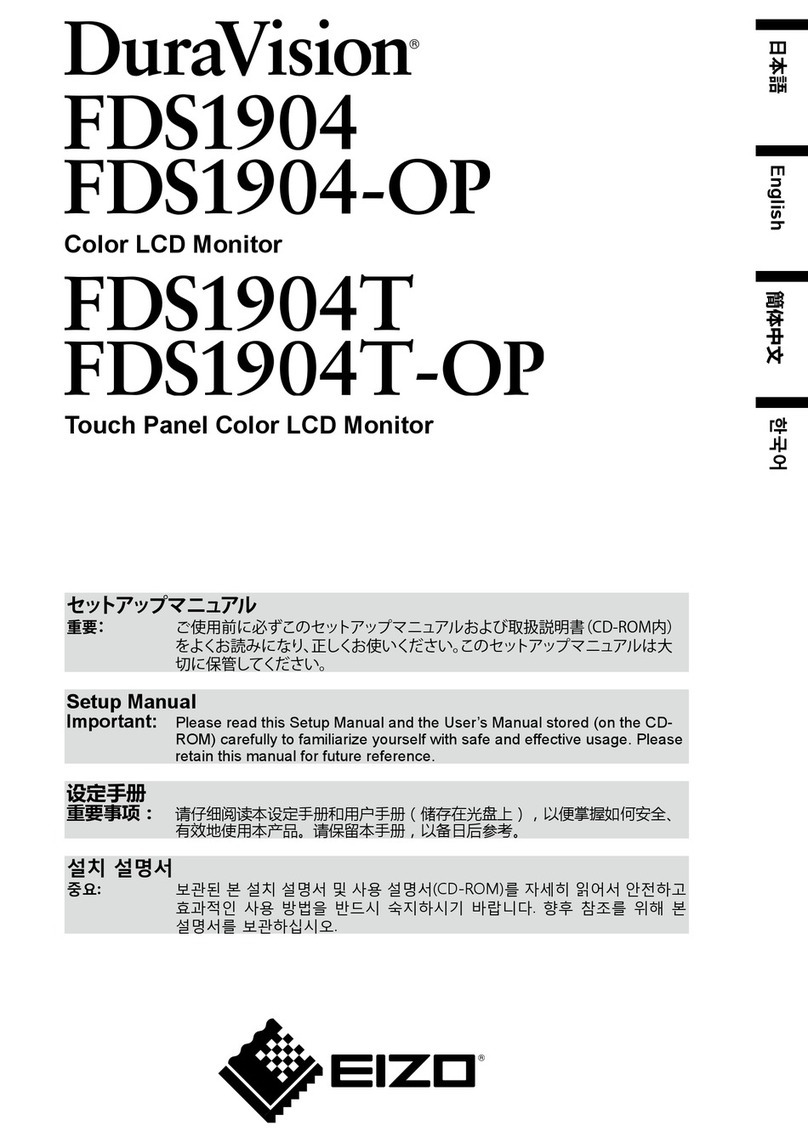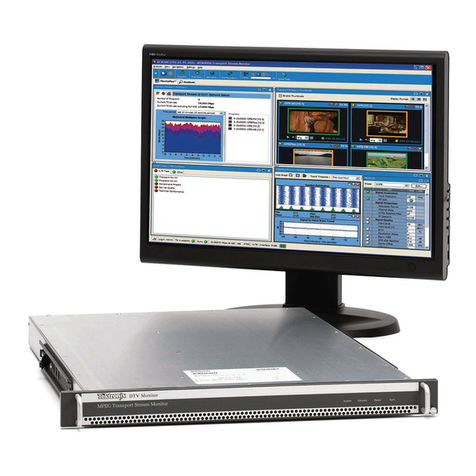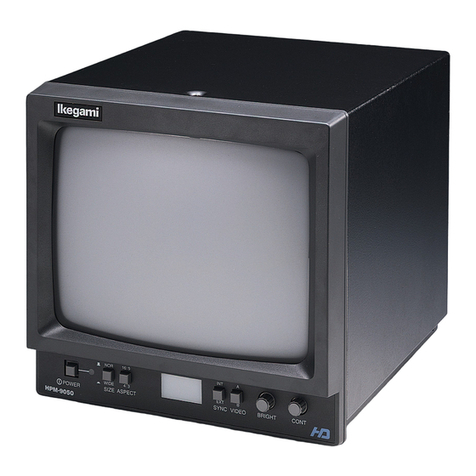Electronics International Inc MVP-50T User manual

Glass Panel Engine MonitorGlass Panel Engine Monitor
Glass Panel Engine MonitorGlass Panel Engine Monitor
Glass Panel Engine Monitor
MVP-50TMVP-50T
MVP-50TMVP-50T
MVP-50T
OI 1206061
Electronics International Inc.Electronics International Inc.
Electronics International Inc.Electronics International Inc.
Electronics International Inc. ®®
®®
®
Rev. A: 3/4/07
63296 Powell Butte Hwy • Bend, OR 97701 • (541) 318-6060 • Buy-EI.com63296 Powell Butte Hwy • Bend, OR 97701 • (541) 318-6060 • Buy-EI.com
63296 Powell Butte Hwy • Bend, OR 97701 • (541) 318-6060 • Buy-EI.com63296 Powell Butte Hwy • Bend, OR 97701 • (541) 318-6060 • Buy-EI.com
63296 Powell Butte Hwy • Bend, OR 97701 • (541) 318-6060 • Buy-EI.com
You must read this manual before installing or operating the instrument. This
manual contains warranty and other information that may affect your decision
to install this product and/or the safety of your aircraft.
Operating InstructionsOperating Instructions
Operating InstructionsOperating Instructions
Operating Instructions
(for Turboprops and Jets)


Important Notice
***** MUST READ *****
Page 1 of 4
If you think it is not important to read this manual, you're wrong! This manual contains
important operating information that may affect the safety of your aircraft.
Read the Warranty / Agreement. There is information in the Warranty / Agreement that may alter your
decision to install this product. If you do not accept the terms of the Warranty / Agreement, do not
install this product.
Electronics International Inc. is not liable or responsible for a pilot’s action or any situation that results in
personal injury, property damage, missed commitments, lack of use of an aircraft or any expenses incurred
due to: product failure, inaccuracy in displayed data or text files, display or display format issues, software
bugs or problems, upgrade or customization issues, misinterpretation of the display, warning and/or limit
settings, calibration problems, installation issues (leaks, mis-wiring, obstructions, damage to aircraft or
components, incorrect installation of any parts, wrong parts, parts that don’t fit, etc.) or any other issues
related to the installation or operation of this product. All of the above are solely the pilot’s and/or
installer’s responsibility. The pilot must understand the operation of this product before flying the
aircraft. The pilot will not allow anyone to operate the aircraft that does not know the operation of this
product. The pilot will keep the instrument Operating Instructions in the aircraft at all times.
By installing this product, the aircraft owner/pilot and installer agree to hold Electronics International Inc.
harmless and in no way responsible for monetary compensation, including punitive damages for any
incident, harm and/or damage associated with this product (including but not limited to the ones listed
above). If you do not agree to the above, DO NOT INSTALL THIS PRODUCT.The pilot, owner
and/or installer may want to obtain an appropriate insurance policy before installing this product.
If you do not have the skills, knowledge, tools, equipment or facility, to perform and determine the
installation of this product is safe, reliable and accurate and to determine this product is operating properly
after installation, DO NOT INSTALL THIS PRODUCT. If the owner/pilot and/or installer are
unwilling to take the responsibility for the installation and operation of this product, DO NOT
INSTALL THIS PRODUCT.This product may be returned for a refund. Contact Electronics
International Inc. for details.
The pilot must understand the operation of this product before flying the aircraft. Do not allow anyone
to operate the aircraft that does not know the operation of this product. Keep the Operating Instructions
in the aircraft at all times.
The ability for this product to detect a problem is directly related to the pilot's ability to program proper
limits and the pilot's interpretation and observation skills.

Important Notice
***** MUST READ *****
Page 2 of 4
It is possible for any instrument to fail thereby displaying inaccurate high, low or jumpy readings.
Therefore, you must be able to recognize an instrument failure and you must be proficient in operating
your aircraft safely in spite of an instrument failure. If you do not have this knowledge or skill, contact
the FAA or a local flight instructor for training prior to flying the aircraft with this instrument.
Set a unique password to protect all of the calibration and setup data in the MVP. If setup or
calibration data is inadvertently or improperly changed, you could get inaccurate readings that may lead
to improper operation of the aircraft or engine. This could result in engine damage and/or an
emergency situation.
Before using the Weight and Balance screen check that the “Weight and Balance Setup” data in the MVP
System Configuration Menu is accurate. Always verify the MVP weight and balance data with you
aircraft’s POH.
Before flying the aircraft verify that the instrument markings displayed on the MVP are accurate with
your POH for every function displayed on the MVP.
The MVP allows the pilot to enter checklists, flight plans and general information through the USB
port. This data must be verified by the pilot before it is used.
The MVP provides calibration data for every channel of the EDC. The accuracy of each function
displayed on the MVP should be verified before the aircraft is released for normal flight.
The MVP must be calibrated to the aircraft fuel system and the MVP's accuracy must be verified before
flying the aircraft.
Fuel Level Accuracy Limitations:
The accuracy limitations of the MVP are listed below. It is the pilot/owner’s obligation to
make anyone flying the aircraft aware of these limitations.
1. Angle of Attack - The MVP must be calibrated with the aircraft in a cruise angle of attack. If
the aircraft is in an angle of attack other than cruise, the MVP may display inaccurate fuel levels
(depending on the mounting location and type of sensor used). If your aircraft does not

Important Notice
***** MUST READ *****
Page 3 of 4
sit at a cruise angle of attack when on the ground, it may not display accurate fuel levels. Test
your aircraft at different angles of attack to determine how the MVP fuel level readings
are affected.
2. Full Fuel Readings - As a tank is filled the fuel sensor may be unable to detect the fuel
entering the upper corners of the fuel tank. If this is the case with your sensor, the MVP may
display fuel levels lower than the actual fuel in the tanks when the tanks are full. When the fuel
level drops to a point where the fuel sensor starts to detect a change, the displayed fuel level
should be accurate. Check the accuracy of your system by comparing the displayed fuel
levels on the MVP to the fuel levels listed in the flight manual at each fill up.
3. Low Fuel Readings - Do not rely on the MVP to determine the fuel level in the tank for
an indicated tank level below 1/8. You should always fly the aircraft in such a manner as to
at least maintain the FAA minimum fuel requirements in the aircraft at all times. Depending
on the mounting location and type of fuel sensor used, the MVP may not be able to
accurately measure the last few gallons of fuel in the tanks.
4. Improper Calibration - If the MVP has not been properly calibrated it will not display
accurate fuel levels in the tanks. It is important to verify the accuracy of the MVP. Always
crosscheck your measured fuel levels in the tanks with the readings on the MVP before
each flight.
5. Poor Connections - Poor connections between the wires leading from the EDC to the fuel
sensors can become intermittent with age. An intermittent connection most likely will show up
as wandering or inaccurate readings on the MVP. Always cross check your measured fuel
levels in the tanks with the readings on the MVP before each flight.
6. Defective Resistive Fuel Level Sensors - Fuel sensors can become intermittent or change
resistance with age. It is not uncommon to find intermittent problems even in new sensors.
An intermittent problem with a fuel sensor most likely will show up as wandering or
inaccurate readings on the MVP. Always cross check the measured fuel levels in the
tanks with the readings on the MVP at each fill up.
If you ever find an inaccuracy issue or any other problem with a fuel level display on
the MVP, disable the fuel level display (see the “Redlines, Limits and Color Setup” screen).
This will alert anyone flying the aircraft to the condition of this display.

Important Notice
***** MUST READ *****
Page 4 of 4
Important Fuel Level Considerations:
DO NOT RELY SOLELY ON THE FUEL LEVEL DISPLAYED ON THE MVP TO
DETERMINE THE FUEL LEVELS IN THE AIRCRAFT. The use of the MVP does not
eliminate or reduce the necessity for the pilot to use good flight planning, preflight and in-
flight techniques for managing fuel. It is important the pilot adopt the practices listed below. If you
are not familiar with these techniques, contact the FAA to acquire proper training.
1. A copy of this operating manual must be in the aircraft at all times.
2. Flight Planning - Always calculate the fuel requirement for each leg of a flight, including
any alternate plans for bad weather. Keep this information available in the aircraft during the
flight. Keep a chart of the published fuel flows for various flight/engine conditions in the
aircraft. Keep a chart of the measured fuel flows for various flights in the aircraft. Measured
fuel flows can be considerably different from published figures.
3. Preflight - Do not rely on the MVP to determine the fuel level in the fuel tanks. The
pilot must visually check/measure the fuel levels in the tanks before every takeoff.
Crosscheck the measured fuel levels with the displayed levels on the MVP. Also, crosscheck
these levels with the fuel requirements for the flight listed in your flight plan.
4. In Flight - Make the MVP part of your normal instrument scan. Crosscheck the fuel levels
displayed on the MVP with your flight plan at each leg of the flight or every 30 minutes
(if a leg is longer than 30 minutes). Calculate the fuel flows from the MVP displayed fuel levels
and compare them with your charts of measured and published fuel flows for the aircraft. If
there is a discrepancy, land the aircraft at the nearest airport and verify the fuel levels.
Discrepancies should be taken seriously.
5. New Pilot or Owner of the Aircraft - If there is a new pilot or owner of the aircraft, it is
the previous aircraft pilot/owner’s responsibility to insure the new pilot has read this
manual and is aware of any accuracy limitations and other important considerations. All
limitations and operating characteristics learned from operating the MVP must be
passed on to the new pilot/owner.

Contents
(Page 1 of 2)
Warranty/Agreement----------------------------------------------------------------------------------------- 1
1.0 Introduction: -------------------------------------------------------------------------------------------- 3
1.1 Overview of the MVP Screens: --------------------------------------------------------- 3
1.2 System Hardware: ---------------------------------------------------------------------- 5
1.3 Cleaning the Screen: -------------------------------------------------------------------- 5
1.4 SELECT Knob and Button Operation: -------------------------------------------------- 6
1.5 Display Dimming: ----------------------------------------------------------------------- 6
2.0 Main Engine Screen: -------------------------------------------------------------------------- 7
2.1 Power-up Add Fuel Message: ---------------------------------------------------------- 7
2.2 Main Screen Layout: --------------------------------------------------------------------- 7
2.3 Arc Gauges: ----------------------------------------------------------------------------- 8
2.4 Vertical Strip Gauges: ------------------------------------------------------------------- 8
2.5 Annunciators: --------------------------------------------------------------------------- 9
2.6 Digital Instruments: --------------------------------------------------------------------- 9
2.7 External Master Warning Light: --------------------------------------------------------- 10
2.8 Voice Alarm Control Panel: ------------------------------------------------------------- 10
2.9 Disabling a Display: --------------------------------------------------------------------- 11
3.0 System Screen: ------------------------------------------------------------------------------- 12
3.1 Trim Indicator: -------------------------------------------------------------------------- 12
3.2 Flap Indicator: -------------------------------------------------------------------------- 12
3.3 Gear Position Indicator: ----------------------------------------------------------------- 12
3.4 Engine and System Functions: ----------------------------------------------------------- 13
3.5 Annunciators: --------------------------------------------------------------------------- 13
3.6 Five Digital Instruments: ---------------------------------------------------------------- 13
4.0 Flight Data Screens Menu: -------------------------------------------------------------------- 13
4.1 Help Screen: --------------------------------------------------------------------------- 13
4.2 System Screen: ------------------------------------------------------------------------- 13
4.3 Add Fuel Screen: ----------------------------------------------------------------------- 14
4.4 Fuel Management Screen: -------------------------------------------------------------- 15
4.5 Timers Screen: ------------------------------------------------------------------------- 16
4.6 Clock and Hour Meters Screen: -------------------------------------------------------- 17
4.7 Weight and Balance Screen: ------------------------------------------------------------ 17
4.8 Checklist Screens: ---------------------------------------------------------------------- 18
4.9 Flight Plan Screens: --------------------------------------------------------------------- 19
4.10 Gen. Info. Screens: -------------------------------------------------------------------- 20
4.11 Data Logs Screens: -------------------------------------------------------------------- 20

5.0 Setup and Control Screens Menu: ------------------------------------------------------------ 21
5.1 USB and Data Recording Screen: ------------------------------------------------------ 21
5.2 Voice and Display Controls Screen: ---------------------------------------------------- 23
5.3 Screens Button Setup Screen: ---------------------------------------------------------- 23
5.4 System Configuration Screens Menu: --------------------------------------------------- 24
6.0 System Configuration Screens: ---------------------------------------------------------------- 24
6.1 System Management Section: ---------------------------------------------------------- 24
6.1.1 USB Flight Data File Manager Screen: ------------------------------------------ 25
6.1.2 USB Config and Software Program Manager Screen: ---------------------------- 26
6.1.3 Change Password Screen: ------------------------------------------------------- 27
6.2 Initial Setup & Calibration Section: ----------------------------------------------------- 27
6.2.1 Engine Type, Ports, Timers, ect. Setup Screen: ---------------------------------- 27
6.2.2 Weight & Balance Setup Screen: ------------------------------------------------ 30
6.2.3 Fuel Tank Calibration Screen: --------------------------------------------------- 30
6.2.4 Pressure Altitude Calibration Screen: -------------------------------------------- 31
6.2.5 Flaps, Trim and Special Function Calibration Screen: ---------------------------- 32
6.2.6 MVP Input/Output Tests Screen: ------------------------------------------------ 33
6.3 EDC Inputs, Functions and Screen Setup Section: -------------------------------------- 33
6.3.1 1. EDC Input to Function Mapping Screen: -------------------------------------- 33
6.3.2 2. Function to Main Screen Mapping Screen: ------------------------------------ 34
6.3.3 3. Function to System Screen Mapping Screen: ---------------------------------- 34
6.3.4 4. Redlines, Limits and Color Setup Screen: ------------------------------------- 35
6.3.5 5. EDC Input Calibration Screen: ------------------------------------------------ 36
Specifications: ------------------------------------------------------------------------------------- 38
A1.0 Appendix: Creating a Checklist, Flight Plan or General Information File
A2.0 Appendix: Recorded Flight Data Formatting
A3.0 Appendix: Calibrating Airspeed
A4.0 Appendix: SettinguptheMVPtoDisplayTorque using a High and Low PressureTransducer
A5.0 Appendix: AddingCustomVoiceWarningFilestotheMVP

1
Warranty / Agreement
Electronics International Inc. (EI) warrants this instrument and system components to be free from defects in
materials and workmanship for a period of one year from the user invoice date. EI will repair or replace any
item under the terms of this Warranty provided the item is returned to the factory prepaid.
1. If you do not agree to and accept ALL the terms of this warranty, DO NOT Install This Product.
You may return the product for a refund. Contact Electronics International Inc. for details.
2. Electronics International Inc. is not liable or responsible for a pilot’s action or any situation that results in
personal injury, property damage, missed commitments, lack of use of an aircraft or any expenses incurred due
to: product failure, inaccuracy in displayed data or text files, display or display format issues, software bugs or
problems, upgrade or customization issues, misinterpretation of the display, warning and/or limit settings,
calibration problems, installation issues (leaks, mis-wiring, obstructions, damage to aircraft or components,
incorrect installation of any parts, wrong parts, parts that don’t fit, etc.) or any other issues related to the
installation or operation of this product. All of the above are solely the pilot’s and/or installer’s responsibility.
The pilot must understand the operation of this product before flying the aircraft. The pilot will not allow
anyone to operate the aircraft that does not know the operation of this product. The pilot will keep the
instrument Operating Instructions in the aircraft at all times.
By installing this product, the aircraft owner/pilot and installer agree to hold Electronics International Inc.
harmless and in no way responsible for monetary compensation, including punitive damages for any incident,
harm and/or damage associated with this product (including but not limited to the ones listed above). If you
do not agree to the above, DO NOT INSTALL THIS PRODUCT.The pilot, owner and/or installer may
want to obtain an appropriate insurance policy before installing this product.
3. This Warranty shall not apply to any product that has been repaired or altered by any person other than
Electronics International Inc., or that has been subjected to misuse, accident, incorrect wiring, negligence,
improper or unprofessional assembly or improper installation by any person. This warranty does not cover
any reimbursement for any person’s time for installation, removal, assembly or repair. Electronics
International retains the right to determine the reason or cause for warranty repair.
4. This warranty does not extend to any machine, vehicle, boat, aircraft or any other device to which the Elec-
tronics International Inc. product may be connected, attached, interconnected or used in conjunction with in
any way.
5. The obligation assumed by Electronics International Inc. under this warranty is limited to repair, replacement
or refund of the product, at the sole discretion of Electronics International Inc.
6. Electronics International Inc. is not liable for expenses incurred by the customer or installer due to factory
updates, modifications, improvements, changes, or any other alterations to the product that may affect the form,
fit, function or operation of the product.
7. Electronics International is not responsible for shipping charges or damages incurred under this Warranty.
More On Next PageMore On Next Page
More On Next PageMore On Next Page
More On Next Page

8. No representative is authorized to assume any other liability for Electronics International Inc. in connection
with the sale of Electronics International Inc. products.
This Warranty is made only to the original user. THIS WARRANTY IS IN LIEU OF ALL OTHER
WARRANTIES OR OBLIGATIONS: EXPRESS OR IMPLIED. MANUFACTURER EXPRESSLY
DISCLAIMS ALL IMPLIED WARRANTIES OF MERCHANTABILITY OR FITNESS FOR A
PARTICULAR PURPOSE. PURCHASER AGREES THAT IN NO EVENT SHALL MANUFAC-
TURER BE LIABLE FOR SPECIAL, INCIDENTAL OR CONSEQUENTIAL DAMAGES, IN-
CLUDING LOST PROFITS OR LOSS OF USE OR OTHER ECONOMIC LOSS. EXCEPT AS
EXPRESSLY PROVIDED HEREIN, MANUFACTURER DISCLAIMS ALL OTHER LIABILITY
TO PURCHASER OR ANY OTHER PERSON IN CONNECTION WITH THE USE OR PER-
FORMANCE OF MANUFACTURER’S PRODUCTS, INCLUDING SPECIFICALLY LIABILITY
IN TORT.
2

MVP-50T
Operation Instructions
1.0 Introduction:
TheMVP-50Tis a state-of-the-art GlassPanel Engine Monitorthatprovidesmost of the engine and system
instrumentsandannunciator foundinanaircraftpanel. Each oftheinstrumentsdisplayed ontheMVP’s Main
EngineScreenprovides featuresnotfoundinmost
multifunctionaldisplaysortraditionalgauges.
Aircraftpanelsequippedwithindividualinstrumentsrequirea
pilottoscanandinterpretamultitudeofgauges spread across
anentirepanel. Byprovidingasinglelocationto viewthe
engineandmanyaircraftsysteminstruments,theMVPreduces
apilot’sworkloadandthechanceof missing a problem.
Additionally,theMVPprovidesboth analoganddigitaldisplays
withdigitsthatblink andchangecolorswhenyellow orred
operatingrangesarereached, an externalMasterWarningLight
thatcanbeplacedinfrontofthepilot,andaVoiceWarning
system. Allofthesefeaturesaredesignedtoalert the pilot the
momentanyfunctionexceedsitsnormaloperatinglimit.
1.1 Overview of the MVP Screens:
MainEngineScreen(seesection2.0): The Main Engine Screendisplaysmost of the engine and aircraft
instrumentsandannunciatorsmonitoredbytheMVP. ThisisthescreentheMVPdisplaysafter power-upandisthe
screenthepilotwillviewformostoftheflight.
System Screen (see section 3.0): The System Screen is
intendedtodisplayfunctionsthatdonotneedtobedisplayed
continuously. IfanyfunctionontheSystemScreengoesinto
theredoryellow,a“System”annunciatorontheMainEngine
Screenwillblink. Inthiswaythepilotisalertedofapotential
problemandshouldviewtheSystemScreenforfurther
information.
3

FlightData Screen Menu (see section 4.0): The Flight
DataScreenMenuprovidesaccesstoscreensdesignedto
assistthepilotinaircraftandengineoperation,flight
management,procedures,rulesandregulationsandawealthof
otherinformation. AlloftheFlightDataScreensaredisplayed
againstabluebackgroundandwillbedisplayedontheleftside
oftheMVPscreen. Afullsetofannunciatorsandfiveprimary
engineinstrumentswillbedisplayedontherightsideofthe
screenagainstablackbackground. Ifanyfunctiononthe
MainorSystemScreengoesintotheredoryellow,the
appropriateannunciatorwillblink,theexternalwarninglight
willblinkandanappropriatevoicewarningwillbeplayed. In
thiswaythepilotisimmediatelyalertedofapotentialproblem
andshouldviewtheappropriatescreenforfurtherinformation.
Setup and Control Screen Menu (see section 5.0): The
SetupandControlScreenMenuprovidesaccesstoscreenscontainingparametersthatthepilotmay want to
changefromtime totimeduringaflight (brightnesscontrol,screenbutton setup,etc.).
SystemConfigurationScreens(seesection 6.0): The System ConfigurationScreen Menu provides a list of
screensusedtoconfiguretheMVP for almost any aircraft. Thesescreensallowyoutosetupfunctions,screens,
instrumentmarkings,limitations,weightandbalancesetup,flapandtrimcalibration,fueltankcalibrationandother
systemsetuprequirements. The“MVP-50TInitialSetup
Checklist”willguideyouthrough the necessary stepstoset
uptheMVPforyouraircraft. The“MVP-50T Initial Setup
Checklist”isprovidedonaseparatebluetag-board.
AlloftheSystemConfigurationScreenswillbedisplayed
withablackbackground and theannunciatorsandengine
instrumentswillnotbedisplayed. Iftheengineisrunning,you
willneedapassword to entertheSystemConfiguration
ScreenMenu. Iftheengine is notrunning,youmayenter the
SystemConfigurationScreenMenu withoutapasswordand
viewthedataonthevariousscreens,butyouwillnot be able
tochangeanydatauntilyouhaveenteredthe correct
password.
4

1.2 System Hardware:
TheMVPhardwareconsistsofthefollowingthree groupsofcomponents:
A. Probes,Transducers and ExtensionCables– These components are used to measure pressures,
temperatures,fuelflow,volts,amps,fuellevelsandmanyotherengine andaircraftsystemfunctions. The
analogsignalsproducedbythetransducersandprobesarerouted through the Extension Cables to
variousEDCinputs.
B. EDC(EngineDataConverter)– TheEDC converts the analog signals from theprobesand
transducerstoadigitalformat. Thisdataistransmittedthreetimespersecond via a two-wire RS422
cabletotheMVPDisplay. AsecondEDCmaybeinstalledtoincreasetheMVP’scapability.
C. MVPDisplay– The MVP receives, processes and displays the RS422 EDC data on its TFT color
display. In addition, the MVPreceivesGPSdata,interfaceswiththeVoice Warning Control Panel and
monitorstheexternalbacklight control line. Also,theMVPtransmitsfueldata to the GPSandcontrols
theexternalMasterWarningLight.
TheMVPreducesthenumberofpanel-mounted instruments from around15toonly1andprovide24
annunciators. TheEDCreducesthetotalnumberofwiresrouted to the aircraft instrument panel by100ormore.
1.3 Cleaning the Screen:
TheMVPincorporates a flatpanelfullcolorTFTdisplay, which shouldbeprotectedfromscratching. TheTFT
displayshouldbecleanedusingonly isopropylalcoholandasoftcleaningcloth. Individuallywrappedlens-cleaning
tissue(usedtocleanglassesorplasticlenses)worksbest.
5
Master
Warning
Light
To
Pwr&Gnd
GPS
Auto Panel

1.4 SELECT Knob and Button Operation:
SELECTKnob: TheSELECTknobcanberotatedorpressed. Dependingonthescreenandfieldbeing
viewed,rotatingtheknobcanmoveanarrow,selectadigit,orchangeadigitsvalue. PressingtheSELECTknob
willchoosethehighlighteditem.
EXITButton: PressingtheEXITbuttonalwaysreturnsyoutothe screen just prior to your pressingtheSELECT
knob. YoucanalwaysreturntotheMainEngineInstrument Screen by repeatedlypressingtheEXITbutton.
SCREENSButton: PressingtheSCREENSbuttonsequencestheMVPthroughalistofFlightDataScreens.
TheFlightDataScreensthatwillbedisplayedcanbepre-selectedontheScreens Button Setup page. The
SCREENSbuttonallowsyouquickaccesstothescreens you use most frequently. Tonavigatetothe“Screens
ButtonSetup”pagestartby viewing the Main EngineScreen,pushtheMenubuttonandselectthe Screens Button
Setupnearthe bottom of the page.
MENUButton: TheMENUbuttondisplaysthemenu for the currentscreenviewed,ifamenuisavailableforthat
screen. Somescreensdonothaveamenu available. When the MENUbuttonispushedwhiledisplayingtheMain
EngineScreen,theFlight DataScreensMenuwillbe displayed.
1.5 Display Dimming:
TheMVPprovidestwomethods ofcontrollingthebrightnessof theTFTdisplay. When the“BrightnessControl”is
setfor“AutoDimming”thedisplaywillautomaticallydimasthe ambientlightreduces. Thelight sensorislocated
nexttotheUSBport on the MVP front panel.
Whenthe“BrightnessControl”isset for “External” anexternalcontrolpotcanbeusedtocontrol the MVP display
brightness. TheElectronicsInternationalCP-1-MVPIntensityControlPotcanbeusedforthispurpose. Note:
TheMVPdisplay willbeatfull intensityifthe“BrightnessControl”issetto“External”andthereisnoexternalpot
connectedto the MVP.
TheBrightnessControlcanbefoundonthe“Voice&DisplayControls”screen. Tonavigatetothe“Voice&
DisplayControls” screen startbyviewingtheMainEngineScreen,pushtheMenubuttonandselecttheVoice &
DisplayControlsscreensnearthebottomofthepage.
6

2.0 Main Engine Screen:
TheMainEngineScreenprovidestheaircraftsystemandengineinstrumentsyouwillviewmostfrequentlyduringa
flight. ThereisimportantinformationpublishedintheImportantNoticesection(foundinthefrontofthis
manual)thatmustbereadbeforeoperatingthis instrument. Please readtheImportant Notice section at this
time.
2.1 Power-up Add Fuel Message:
AnaddfuelmessagelocatedinthelowercentersectionofthescreenwillappearwhentheMVP is powered up.
Thepurposeofthismessageistoremindyouto update the fuel computer ifyouhaveaddedfueltotheaircraft. The
MVPnotonlymeasures and displaysthefuelinthefuel tanksbutitalsodisplaysthe fuel on-boardtheaircraft
calculatedfromfuelflow. Thisallowsyoutocross check fuelreadingstoinsureaccuracy.
Note:As longasthe“AddFuelMessage”isdisplayedall the annunciators will belit. Thisfeatureprovidesatest
fortheannunciators.
2.2 Main Screen Layout:
TheMainEngineScreenislaidoutinfourareas:
Arc Gauges (see section 2.3): The N1, N2,
ITTandTorquegaugeswillbedisplayed inthe
centerleftportion oftheMainEngineScreen.
Vertical Strip Gauges (see section 2.4): A
seriesofVerticalStripGauges(withdigital
readouts)arelocatedinthecenterright portion
oftheMain EngineScreen.
Annunciators(see section 2.5): Fourteen
System/EngineAnnunciatorsaredisplayedin
two rows at the top of the screen. Ten
additionalMainEngineScreenAnnunciators
arelocatedbelowthesefourteen annunciators.
Digital Instruments (see section 2.6): At
thebottomoftheMainEngineScreen are three
sectionsfordisplayingadditionalinstrumentsinadigitalformat.
7

2.3 Arc Gauges:
TheArcGaugesincorporateadigitalreadoutandananalogarc. Thecolorofthe
digitalreadoutwillreflectthecurrentoperatingleveloftheinstrument(i.e.,iftheN1
isoperatinginthered,thedigitalreadoutwillbered).
Thedigitaldisplaycanbesettoblinkwhenafunctionsoperatinglevelreachesa
yellowand/orredoperatingrange. Tostoptheblinking,pushanybutton,orrotate
theSELECTknob. Also,acknowledgingavoicewarningusingtheexternal
“VoiceAlarmControlPanel”willstoptheblinkingofanydigitaldisplay. The“4.
Redlines,LimitsandColorSetup”screenfoundinsection6.3.4ofthismanual
providesacontroltoenableordisabletheblinkingforanyfunctionandsetits
operatinglimits.
ThelocationandtypesoffunctionsdisplayedintheArcGaugeareacanbeset. Thiscanbeaccomplishedinthe“2.
2.FunctiontoMainScreenMapping”screenfoundinsection6.3.2ofthismanual.
2.4 Vertical Strip Gauges:
TheVerticalStripGaugesprovidethefollowingfeatures:
A. ThecoloredoperatingrangesshownontheVertical Stripareprogrammableandmaybesetupforany
aircraft. Seesection6.3.4ofthismanualtosetthe operating ranges and various displaycolorsforany
instrumentdisplayedon theMVPscreen.
B. EachVerticalStripGaugefeaturesanarrow indicating itscurrent
operatinglevel. Also,thearrowallowsyoutointerpret rate and
trendinformationandprovidesfieldof visiondata.
C. AdigitaldisplayisfeaturedwitheachVerticalStripGauge.
D. Thedigitaldisplaycanbesettoblinkwhenafunction’soperating
levelreachesayellowand/orredoperatingrange. Tostopthe
blinking,pushanybutton,orrotatetheSelectknob. Also,
acknowledgingavoicewarningusingtheexternal“VoiceAlarm
ControlPanel”willstoptheblinkingofanydigitaldisplay. The
“4.Redlines,LimitsandColorSetup”screenfoundinsection6.3.4ofthismanualprovidesacontrolto
enableordisabletheblinkingforanyfunctionandsetitsoperatinglimits.
E. TheVerticalStripGaugesmay be rearranged orconfiguredtodisplayvariousfunctions. See section
6.3.2ofthismanualto setwhichfunctionistobedisplayed ataspecificdisplaylocation.
8

9
2.5 Annunciators:
AnEDCtemperatureorresistivefuellevelchannelcanbeconnectedtoa switch, relay or device via a VI-221
interfacecircuit. Thesignalsfrom these devicesareusuallyhighorlow and canbeusedtogeneratean annunciator.
Anannunciatorcanbedisplayedinanycolor for a high or lowsignal. Ifthecolorwhitewasselectedforoneofthe
signallevels,theannunciatorwillnotbedisplayedforthatsignallevel.
TANK VENT
FUEL
BAG DOOR
DOOR SEAL
FUEL BYPS
AFT CHPITOT HT
DEICE
ISLM MSG
BETA
AtthetopoftheMainEngineScreenarethreerowsofannunciators. Thetoptworowsofannunciatorsaredefined
bytheinstaller. The bottomrowofannunciatorsisassociated withfunctionsdisplayedonthe MainEngineScreen.
Also,atthefarrightof the bottomrowisa“System”annunciator. If anyfunctionfoundontheSystemScreen goes
intotheredoryellow, the“System”annunciatorwillblinktheappropriate color. In this waythepilotisalertedofa
potentialproblemand shouldviewtheSystemScreen forfurtherinformationand tostopthe“System”annunciator
fromblinking.
Ifanyfunctionfound ontheMainEngineScreengoes intotheredoryellow, theappropriateannunciatorinthe
bottomrowwillblink.
Ifanyannunciatorfoundonthe top two rows of theMainEngineScreengoestoanycolorother than white, the
appropriateannunciatorwill light. Ifthelitcoloris redoryellow,theappropriateannunciatorwillalsoblink.
Tostoptheblinkingof anyannunciator,pushany button,orrotatetheSELECTknobwhile viewingtheMainEngine
Screen. Also,acknowledgingavoicewarningusingtheexternal“VoiceAlarmControlPanel”will stoptheblinking
regardlessofwhatscreen youareviewing.
Note:Blinkingonredand/oryellow foranyfunctionscanbedisabledin the“4.Redlines,LimitsandColor Setup”
screen(see section 6.3.4).
Note:Totesttheannunciators,pushandholdthe“Exit”button. Allavailableannunciatorswilllight.
2.6 Digital Instruments:
AtthebottomoftheMainEngineScreenarethreeareasfordigitalinstruments. Thebottomcentersectionmaybe
switchedbetweenTrim(includesGearandFlaps),Clocks,FlightTimer,DownTimerandUpTimer. Pushandturn
the“Select”knobtodisplaythevariousfunctions.
Ifafunctiondisplayedonadigitalinstrumentgoesintheredoryellowoperatingrange,thedigitaldisplaywillblink
theappropriatecolor. Tostoptheblinking,pushanybutton,orrotatetheSELECTknobwhileviewingtheMain
EngineScreen. Also,acknowledgingavoicewarningusingtheexternal“VoiceAlarmControlPanel”willstopthe
blinkingregardlessofwhatscreenyouareviewing.

10
2.7 External Master Warning Light:
Aredexternal“MasterWarning Light”(providedwiththeMVP) maybemountedinfront
ofthepilot, highontheaircraft instrumentpanel. Thiswarninglight providesaheads-up
visualwarning. Ifprogrammed todoso,the“MasterWarningLight”willblink anytimethe
operatinglevelof anymonitoredfunctionreachesaredand/oryellowoperating limit. Pushinganybutton,or
rotatingorpushingtheSelectknobwhentheMasterWarningLightisblinkingwillacknowledgetheblinking(visual
warning)andtheblinkingwillstop. Also,acknowledgingavoicewarningusingthe external“VoiceAlarmControl
Panel”willstoptheblinkingofthe“MasterWarningLight.”
Acknowledgingayellow blinkingdisplaywillcausetheMasterWarningLighttogoout. Acknowledgingared
blinkingdisplaywill causetheMasterWarningLighttostop blinkingandgosolidred.
The“4.Redlines,LimitsandColor Setup” screenfoundinthe6.3.4sectionofthis manual provides acontrolto
enableordisabletheMasterWarning Lightforanyfunction. Thisscreenalsoprovidesacontrol to blink red and/or
yellowlimits.
Aswithanywarning system, itisimportantthatthereare no falsealarms. Falsealarmscandesensitizea pilottoall
alarms,whichcancausea serioussituationtogoundetected. Settingproperred andyellowlimitsforeachfunction
isakeystepineliminatingfalsealarms.
2.8 Voice Alarm Control Panel:
TheVoiceAlarm ControlPanelisanexternalpanel usedtocontrolthevoicewarnings
providedbytheMVP. The MVPvoicewarningsystemisapowerfulsystemthatprovidesan
immediateandintelligentaudiblewarningregardlessofthepilot’sheadpositionorfocus. The
instantanoperating levelofanyfunction reachesaredand/or yellowoperatinglimit,a chime
willsoundinthe headsetandapleasantfemale voicewillannunciateaphrase, suchas:
“CheckOilPressure,”or“CheckFuelPressure.”
Task List: If two or more alarmsare activated, the alarms are placed ona task list and are announced oneat a
timewithaone-seconddelaybetweenalarms. Afterthe last alarm on thetasklistisannouncedafive-seconddelay
willoccur. Thealarmsthenonceagain announcedinorder.
Power-upAnnouncement: WhentheMVPispoweredupandtheVoiceAlarmControlPanelswitchisplacedin
the“ON”position,the MVPwillannounce,“VoiceAnnunciator enabled. Haveaniceflight.” Thisannouncement
willbemadeonlyonce,at thebeginningofeachflight.
AcknowledgingandSilencinganAlarmforOneMinute: Toacknowledgeandsilenceanalarm,pushthe
switchontheVoiceAlarm ControlPanelmomentarilytothe “ACK”(acknowledge)position. Ahightonebeepwill
beheardintheheadsetand allactivealarmswillbesilencedfor one minute. Thisishandyifyoudon’twant to
permanentlyshutoffany alarmsbutyouneedsilence foroneminuteinorderto dealwithotherpressingmatters.
Afteroneminute thesilencedalarms(ifstillactive)onceagainwillbeannouncedintheheadset.
Duringthetimeoneormorealarmsaresilenced,any newlyactivatedalarmwillbeannouncedimmediatelyinspite
oftheminuteof silence. To silencethisnewalarm,onceagain pushtheControlPanelSwitch oncemomentarilyto
the“ACK”position,whichwillsilencethenewalarmand allactivealarmsforoneminute.
MasterWarning

11
AcknowledgingandSilencinganAlarmfor10Minutes: To acknowledge andsilenceanyactivealarmfor10
minutes,pushtheVoiceAlarmControlPanelswitch tothe“ACK”positionthreetimes within threesecondsorless.
Onthethirdpush,a low toneboopwillbeheardin the headset,indicatingthatallactivealarms will besilencedfor
10minutes.
TurningtheVoiceWarningSystem“OFF”: TodisabletheMVPVoiceWarning System, silence all voice
alarmsintheheadsetandresetany silence delay times, settheVoiceAlarm ControlPanelswitchtothe“OFF”
position. WhentheControlPanelSwitchis once againsettothe“ON”position,theMVPwill announce “Voice
Annunciatorenabled.” Thiswillbefollowedbytheannouncementofanyactivealarms.
AdjustingtheVolumeoftheVoiceWarnings: The “Voice &DisplayControls”screen provides a control to
adjustthevolumelevel of thevoicewarnings. To navigatetothe“Voice&Display Control”screenstartbyviewing
theMainEngineScreen,push the Menubuttonandselectthe“Voice
&DisplayControl”screennearthebottonofthepage.
Setup: The“4.Redlines,LimitsandColor Setup” screen(foundin
section6.3.4ofthismanual)providesthefollowing:
A. Asetting toenableordisableavoicewarningforagiven
function.
B. Settingsforactivatinga voicewarningwhena“red”and/or
“yellow”limitisreachedforagivenfunction.
C. Amethodtoselectthevoicewarningfilethat will be
playedwhenafunction reachesalimit. Customvoice
warningfilesmay beinstalledusingtheUSBportlocated
onthefrontoftheMVP(seesection6.1.1of this manual).
FalseAlarms: As withanywarningsystem,itisimportantthere are no falsealarms. Falsealarmscandesensitizea
pilottoallalarms,which can causeaserioussituationtogoundetected. Setting proper redandyellowlimitsfor
eachfunctionisakeystepineliminating falsealarms.
2.9 Disabling a Display:
Anydisplayshownon theMainEngineorSystemScreen maybedisabled. Thisallowsan improperlyoperating
functionontheMVPto be designated“DISABLED.” TodisableanMVPinstrument display, seethe“4.Redlines,
LimitsandColorSetup”screen(foundin section 6.3.4 ofthismanual). Thisfeatureispasswordprotected.

12
3.0 System Screen:
TheSystemScreenisintendedtodisplaysystemfunctionsandtheconfigurationoftheaircraft. Thisgivesthepilot
onelocation(i.e.;onescreen)tofindallofthepertinentsystemfunctionsandconfigurationinformationonthe
aircraft. Normallythesefunctionswouldnotneedtobedisplayedcontinuously. Thefollowingfeaturesinthe
SystemScreenareprovided:
3.1 Trim Indicator:
TheTrimIndicatorlocatedinthetoprightcorneroftheSystemScreenprovideselevator,rudder,andailerontrim
indications. Onlytheapplicabletrimfunctionsforyouraircraftmaybedisplayed.
Whentheelevatoristrimmedtheyellowboxwillmove
upordownontheverticalline. Theyellowboxshould
moveupasthenoseoftheaircraftistrimmedup.
Neutralisinthecenterofthehorizontalline.
Whentherudderistrimmedtheyellowboxwillmove
rightorleftonthehorizontalline. Theyellowboxshould
moverightasthenoseoftheaircraftistrimmedright.
Neutralisinthecenteroftheverticalline.
Whentheaileronsaretrimmedthebargraphtotherightofthedisplaywillmoveupordownfromthehorizontal
line. Thebargraphshouldmoveupastherightwingistrimmedup. Neutraliswhenonlyonebarisshowingonthe
horizontalline.
3.2 Flap Indicator:
Theflapsareshowninthewingrootsofthepicturedaircraft. Astheflapareextendedthedisplayedflapsinthe
picturewillmovedownward. Also,theFlapAnglewillbedisplayedindegreesjustundertheleftflap.
3.3 Gear Position Indicator:
Thelandinggearsaredisplayedinthepicturedaircraft. Whenthewheelsareretracted,thepicturedgearswillshow
inthedownposition. Duringtransitiontheword“UNSAFE”willbeshowninred. Ifagearishung,itwillbe
shownintheuppositionwiththeword“UNSAFE.”
TheMVPGearPositionIndicatorisnotareplacementfortheGearLightslocatedontheaircraftinstrumentpanel.
TheMVPGearPositionIndicatorshouldbeusedasabackup. Theyareprovidedtogivethepilotasinglelocation
toviewtheaircraftconfiguration. TheGearLightslocatedontheaircraftinstrumentpanelshouldbeviewedbefore
landing.
Other manuals for MVP-50T
1
Table of contents
Other Electronics International Inc Monitor manuals

Electronics International Inc
Electronics International Inc CGR-30P Owner's manual

Electronics International Inc
Electronics International Inc MVP-50T User manual

Electronics International Inc
Electronics International Inc CGR-30C User manual

Electronics International Inc
Electronics International Inc MVP-50T User manual

Electronics International Inc
Electronics International Inc MVP-50P User manual

Electronics International Inc
Electronics International Inc MVP-50P User manual
